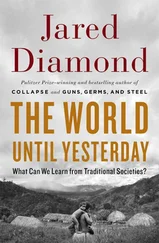Jared Diamond - Guns, Germs & Steel
Здесь есть возможность читать онлайн «Jared Diamond - Guns, Germs & Steel» весь текст электронной книги совершенно бесплатно (целиком полную версию без сокращений). В некоторых случаях можно слушать аудио, скачать через торрент в формате fb2 и присутствует краткое содержание. Жанр: 105. Описание произведения, (предисловие) а так же отзывы посетителей доступны на портале библиотеки ЛибКат.
- Название:Guns, Germs & Steel
- Автор:
- Жанр:
- Год:неизвестен
- ISBN:нет данных
- Рейтинг книги:5 / 5. Голосов: 1
-
Избранное:Добавить в избранное
- Отзывы:
-
Ваша оценка:
- 100
- 1
- 2
- 3
- 4
- 5
Guns, Germs & Steel: краткое содержание, описание и аннотация
Предлагаем к чтению аннотацию, описание, краткое содержание или предисловие (зависит от того, что написал сам автор книги «Guns, Germs & Steel»). Если вы не нашли необходимую информацию о книге — напишите в комментариях, мы постараемся отыскать её.
Guns, Germs & Steel — читать онлайн бесплатно полную книгу (весь текст) целиком
Ниже представлен текст книги, разбитый по страницам. Система сохранения места последней прочитанной страницы, позволяет с удобством читать онлайн бесплатно книгу «Guns, Germs & Steel», без необходимости каждый раз заново искать на чём Вы остановились. Поставьте закладку, и сможете в любой момент перейти на страницу, на которой закончили чтение.
Интервал:
Закладка:
138 • GUNS, GERMS, AND STEEL
(for example, by a root that genetically duplicates the parent plant). Thus, the high percentage of hermaphroditic selfers in the Fertile Crescent flora aided early farmers, because it meant that a high percentage of the wild flora had a reproductive biology convenient for humans.
Selfers were also convenient for early farmers in that they occasionally did become cross-pollinated, thereby generating new varieties among which to select. That occasional cross-pollination occurred not only between individuals of the same species, but also between related species to produce interspecific hybrids. One such hybrid among Fertile Crescent selfers, bread wheat, became the most valuable crop in the modern world.
Of the first eight significant crops to have been domesticated in the Fertile Crescent, all were selfers. Of the three selfer cereals among them— einkorn wheat, emmer wheat, and barley—the wheats offered the additional advantage of a high protein content, 8-14 percent. In contrast, the most important cereal crops of eastern Asia and of the New World—rice and corn, respectively—had a lower protein content that posed significant nutritional problems.
Those were some of the advantages that the Fertile Crescent's flora afforded the first farmers: it included an unusually high percentage of wild plants suitable for domestication. However, the Mediterranean climate zone of the Fertile Crescent extends westward through much of southern Europe and northwestern Africa. There are also zones of similar Mediterranean climates in four other parts of the world: California, Chile, southwestern Australia, and South Africa (Figure 8.2). Yet those other Mediterranean zones not only failed to rival the Fertile Crescent as early sites of food production; they never gave rise to indigenous agriculture at all. What advantage did that particular Mediterranean zone of western Eurasia enjoy?
It turns out that it, and especially its Fertile Crescent portion, possessed at least five advantages over other Mediterranean zones. First, western Eurasia has by far the world's largest zone of Mediterranean climate. As a result, it has a high diversity of wild plant and animal species, higher than in the comparatively tiny Mediterranean zones of southwestern Australia and Chile. Second, among Mediterranean zones, western Eurasia's experiences the greatest climatic variation from season to season and year to year. That variation favored the evolution, among the flora, of an espe-
APPLES OR INDIANS • 139
v?-:iJ>*V: Mi \ffK'-' * :;:.k . v-.K>:?*:> *-;&••::'.•• •.'!.;'" '•:>! .!wSlЈ –.– '>i •; ;.?
Figure 8.2. The world's zones of Mediterranean climate.
cially high percentage of annual plants. The combination of these two factors—a high diversity of species and a high percentage of annuals—means that western Eurasia's Mediterranean zone is the one with by far the highest diversity of annuals.
The significance of that botanical wealth for humans is illustrated by the geographer Mark Blunder's studies of wild grass distributions. Among the world's thousands of wild grass species, Blumler tabulated the 56 with the largest seeds, the cream of nature's crop: the grass species with seeds at least 10 times heavier than the median grass species (see Table 8.1). Virtually all of them are native to Mediterranean zones or other seasonally dry environments. Furthermore, they are overwhelmingly concentrated in the Fertile Crescent or other parts of western Eurasia's Mediterranean zone, which offered a huge selection to incipient farmers: about 32 of the world's 56 prize wild grasses! Specifically, barley and emmer wheat, the two earliest important crops of the Fertile Crescent, rank respectively 3rd and 13th in seed size among those top 56. In contrast, the Mediterranean zone of Chile offered only two of those species, California and southern Africa just one each, and southwestern Australia none at all. That fact alone goes a long way toward explaining the course of human history.
A third advantage of the Fertile Crescent's Mediterranean zone is that
I 4 O • GUNS, GERMS, AND STEEL
table 8.1 World Distribution of Large-Seeded Grass Species
Area
Number of Species
West Asia, Europe, North Africa
33
Mediterranean zone
32
England
1
East Asia
6
Sub-Saharan Africa
4
Americas
11
North America
4
Mesoamerica
5
South America
2
Northern Australia
2
Total:
56
Table 12,1 of Mark Blunder's Ph.D. dissertation, "Seed Weight and Environment in Mediterranean-type Grasslands in California and Israel" (University of California, Berkeley, 1992), listed the world's 56 heaviest-seeded wild grass species (excluding bamboos) for which data were available. Grain weight in those species ranged from 10 milligrams to over 40 milligrams, about 10 times greater than the median value for all of the world's grass species. Those 56 species make up less than 1 percent of the world's grass species. This table shows that these prize grasses are overwhelmingly concentrated in the Mediterranean zone of western Eurasia.
it provides a wide range of altitudes and topographies within a short distance. Its range of elevations, from the lowest spot on Earth {the Dead Sea) to mountains of 18,000 feet {near Teheran), ensures a corresponding variety of environments, hence a high diversity of the wild plants serving as potential ancestors of crops. Those mountains are in proximity to gentle lowlands with rivers, flood plains, and deserts suitable for irrigation agriculture. In contrast, the Mediterranean zones of southwestern Australia and, to a lesser degree, of South Africa and western Europe offer a narrower range of altitudes, habitats, and topographies.
The range of altitudes in the Fertile Crescent meant staggered harvest seasons: plants at higher elevations produced seeds somewhat later than plants at lower elevations. As a result, hunter-gatherers could move up a mountainside harvesting grain seeds as they matured, instead of being overwhelmed by a concentrated harvest season at a single altitude, where all grains matured simultaneously. When cultivation began, it was a simple
Интервал:
Закладка:
Похожие книги на «Guns, Germs & Steel»
Представляем Вашему вниманию похожие книги на «Guns, Germs & Steel» списком для выбора. Мы отобрали схожую по названию и смыслу литературу в надежде предоставить читателям больше вариантов отыскать новые, интересные, ещё непрочитанные произведения.
Обсуждение, отзывы о книге «Guns, Germs & Steel» и просто собственные мнения читателей. Оставьте ваши комментарии, напишите, что Вы думаете о произведении, его смысле или главных героях. Укажите что конкретно понравилось, а что нет, и почему Вы так считаете.










